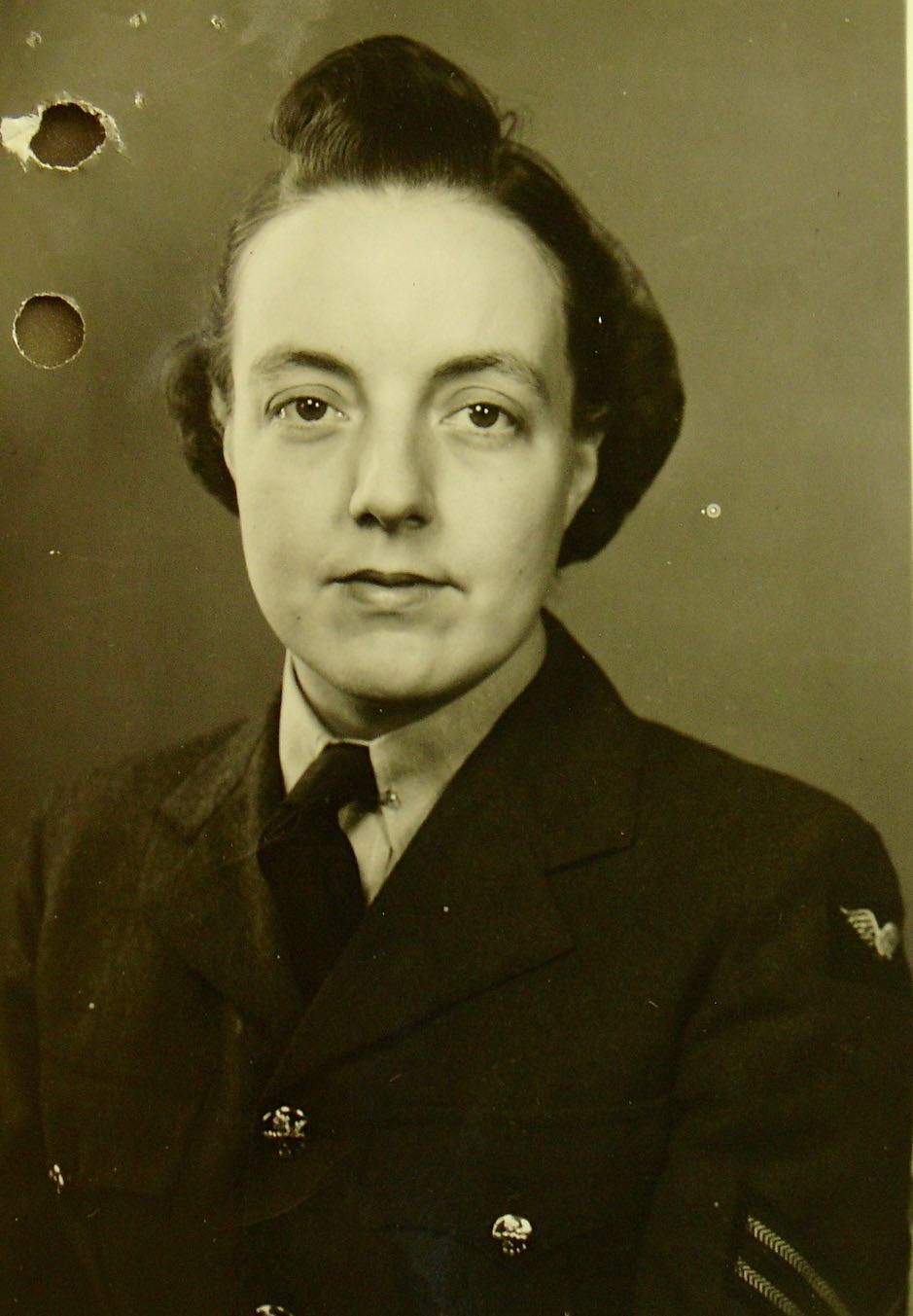
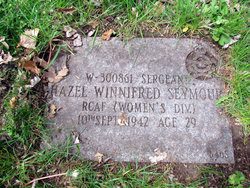
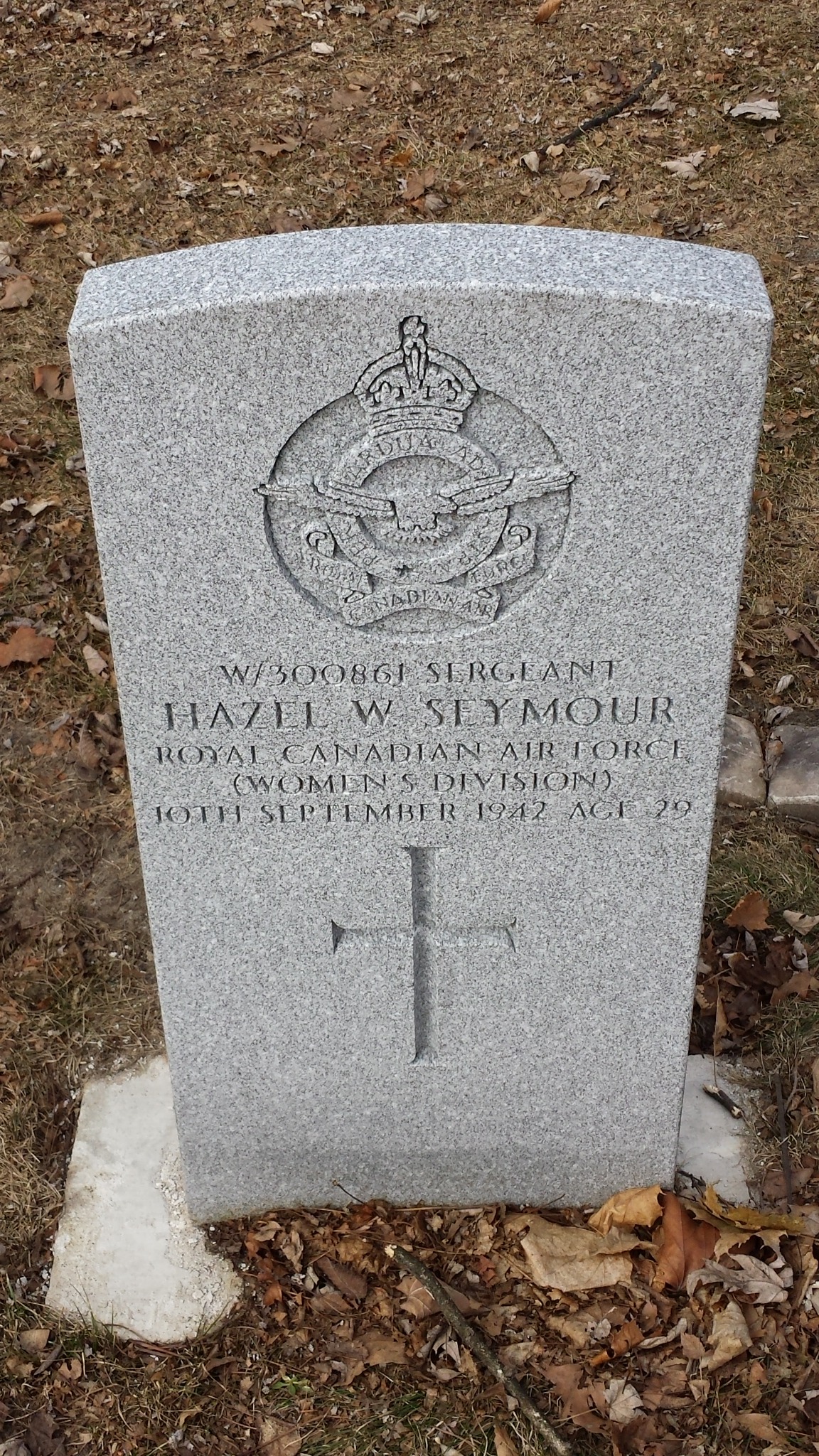

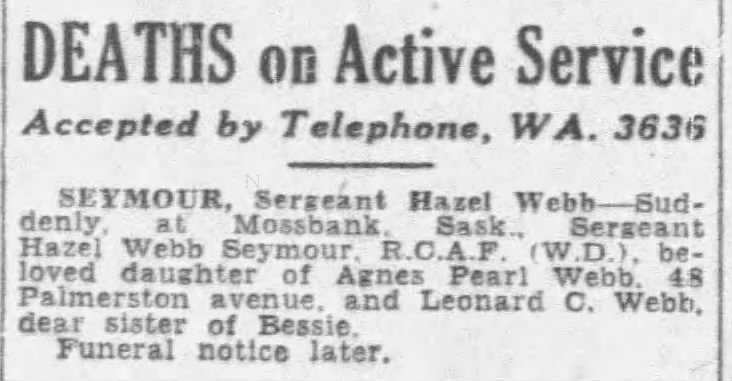
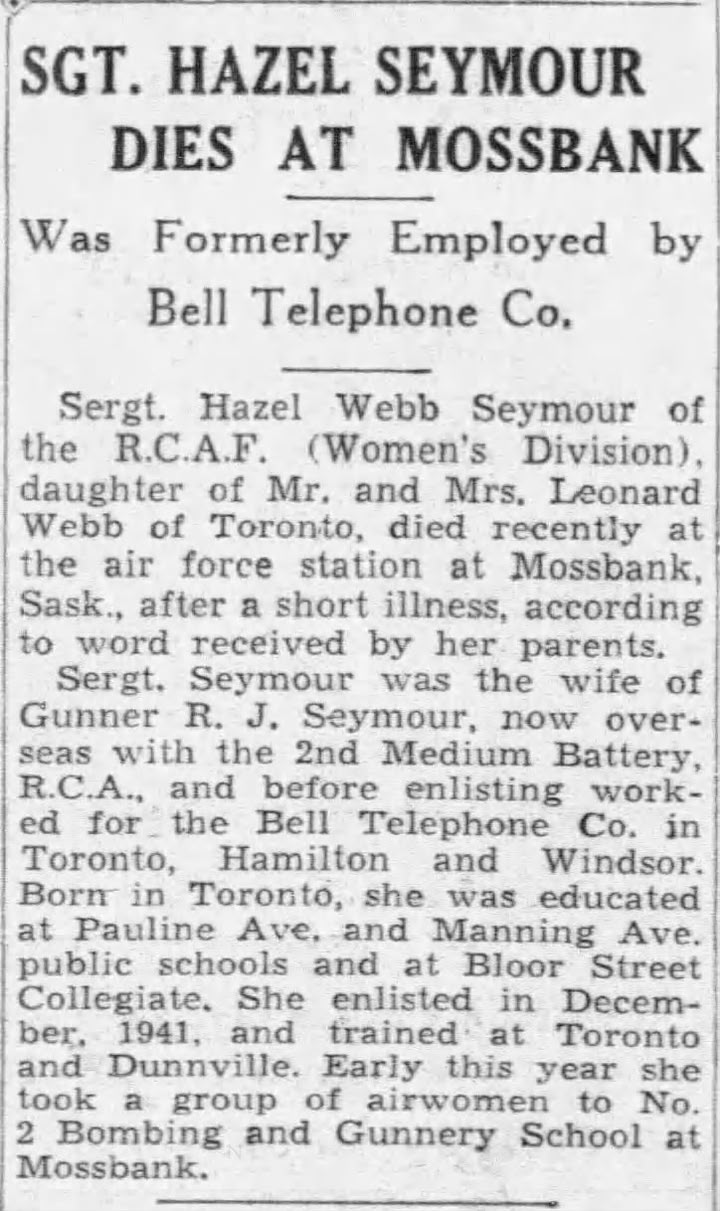
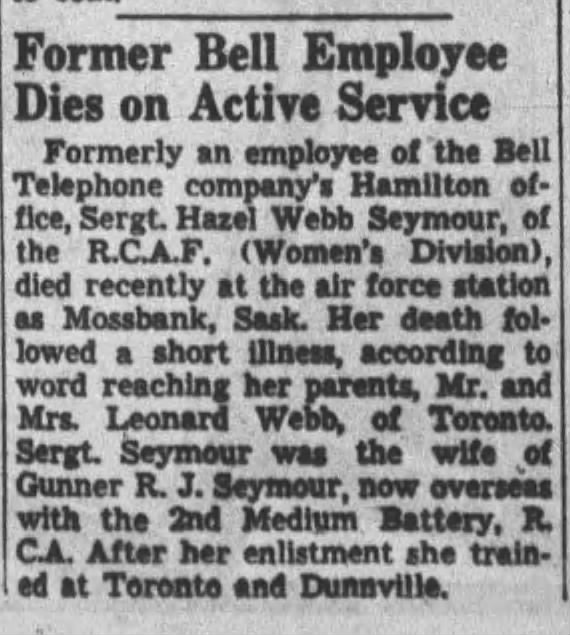
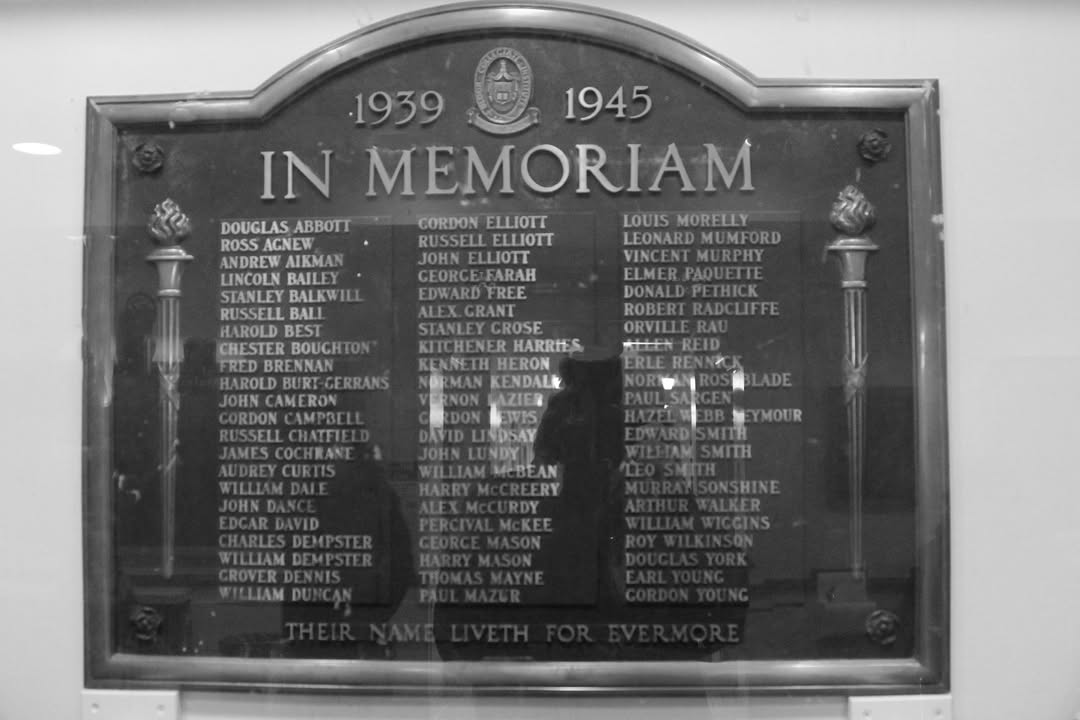
October 25, 1912 - September 10, 1942








Hazel Winnifred Webb was the second daughter of Leonard Carliss Webb and his wife Agnes Pearl (nee Beeton) Webb of Toronto. Mr. Webb was born in Toronto and Mrs. Webb was from England. Hazel had an older sister, Bessie Beaton Webb. It appears Mr. and Mrs. Webb later separated as they had different addresses, about a 30 minute walk from each other in Toronto.
Hazel completed Grade 10. She had the typical childhood illnesses including measles, mumps, and chicken pox. She had her appendix removed when she was 15 years old.
In October 1934, Hazel married Ronald John Seymour in a Baptist church. He was unemployed and Hazel was supporting them as a Commercial Service Observer for Bell Telephone Co. of Canada for 12 years, as well as a travelling representative. They separated for four years, but at the start of the Second World War at his enlistment, she took him back. Ronald was a Private with the Royal Canadian Ordnance Corps (RCOC) 2nd Division, Canadian Army and was sent overseas.
Hazel enlisted in the RCAF (WD) on December 18, 1941 in Hamilton, Ontario. She was 28 years old stood 5'5" tall, weighed 131 pounds had brown hair and brown eyes. She noted she attended the United Church. She was assessed: "played piano very well. Takes the lead. Gets along with women. Organization skills. Industrious and capable." She was taken on as a clerk (accounting) and later held an administration position.
Training and Postings:
March 27, 1942: Trade Proficiency: Excellent. Character Assessment: Very Good. On April 25, 1942, at No. 6 M Depot: "One of the best on the course -- always cheerful and will make a wonderfully reliable and good NCO. Suitable for a difficult station."
On July 16, 1942 at No. 6 Manning Depot, Toronto, Sgt Seymour was admitted to hospital. Complaint: Nervousness, inability to sleep, tendency to depression. Diagnosis: Exhaustion. Examination: Patient has been handling a trying job and for some time it has been troubling her. Now she feels that she incapable of doing the work. She cannot sleep at night, has become quite sensitive, bites her nails constantly, and in general is completely exhausted. She has a small cystic enlargement at the angle of her jaw on the right side. This is insignificant but recently she has worried about it and attached a great importance to it, she has been hospitalized and given sedatives. On July 17: Patient somewhat improved but still worrying about her work. However, she is much more rested and does not cry as easily as she did yesterday. Has begun to take an interest in reading, etc. July 23: Greatly improved today. Less excitable with more interest in reading, having visitors, etc. Treatment: Rest in bed; Soda bicarbonate. Discharged to duty."
On August 7, 1942, Sgt Seymour was admitted to hospital in Toronto, on leave. Dr. Baillie wrote: "Patient admitted with diagnosis of emotional instability, She is reported to have been complaining of inability to sleep and of being tired out. There is also the complaint of a swollen gland at angle of right jaw. Patient, since returing east has not been sleeping, does not seem to be able to make herself do her work, is confused readily and lacks initiative. I happen to know a good deal about this girl's surroundings. Her father was a patient here with ruptured intervertebral disc. He was operated on with good recovery although he does not acknowledge same. (I knew her mother at public school and a few details of her history. She was a spoiled child. Her marital life has been extremely difficult for many years, for which she was in part responsible.) Patient herself married against her parents' wishes and probably picking on the most undesirable individual in her neighbourhood. These statements are made from my own personal knowledge. She has one sister living at home. Patient was born in Toronto and is now 29 years of age. She attended Manning Avenue School and Bloor Collegiate. Passed her junior matriculation at 16. She was married in 1934 and actually she has supported her husband by working at the Bell Telephone where she appears to bear an excellent reputation both personally and in her work. She separated from her husband in 1936. Her husband left her without cause. On direct inquiry, her appetite is usually good. Since her nervousness, she has had no desire to eat. Not constipated. No indigestion. Not subject to chest or head colds. No sore throat. Heart normal. Menses normal. She has a leukorrehea (vaginal discharge) which is troublesome at times. She is well built, well nourished and presents no evidence of any organic nervous disease. Teeth sound. Throat healthy. This patient impresses me as having an anxiety state, the basis of which is not evident on first examination. To have definite sedation. On August 11: Patient received sedation for sleep at night and slept well. She looks a different individual. She is bright, cheerful, alert and anxious to get back to work. August 13: Patient had a marked emotional upset this afternoon. As far as one can ascertain, there is not direct cause. However, we would like to point out that she had frequent visits from her mother and had a long visit with her father, both of whom are markedly incompatible and this has reflected on the girl. In addition, Dr. Grimshaw has made a vaginal smear, showing the presence of trichomoniasis (a sexually transmitted disease). She will receive special attention in this regard. Patient is placed in isolation for closer observation. August 14: Patient slept well. She is completely changed again and back to her normal. It is quite obvious that she has been working hard and has been too conscientious in her work at her own expense. August 15: Patient has made a complete recovery from her anxiety state although she is not sleeping well as one would hope for. August 17: It is not considered that this patient requires any more hospital care. Small doses of luminal at night are indicated, also return to work. She has developed an anxiety state which is based upon first, her home environmet (she is far better out of Toronto), and second, some anxiety regarding her own personal health plus undue concentration on her work. She may require a certain amount of leniency in the coming week or ten days and then should return to normal."
On August 31, 1942, F/L Blair discharged Sgt. Seymour. "Final Diagnosis: Hysteria. Tricamonad vaginitis. Complaint: Can't sleep. Nervous. Lump in neck. Vaginitis. History: Has had lump in neck for some time and has been variously told it was a gland and cyst. Occasionally slightly painful. Has been treated for trichomonad infection for several weeks with bicarbonate douches and picric acid cones. Unable to sleep since a course in June. Feels she has too much responsibility for her capabilities. Has marked feeling of inferiority. CONDITION ON DISCHARGE: To D.P. and N.H. for investigation by 1. Anti TB League and 2. Psychiatrist."
In a letter dated September 2, 1942, Regina to Dr. Carmichael, District Administrator, Dept of Pensions and National Health from Dr. O. E. Rothwell: "I wish to report on examination made on this woman on September 1. She states she is now on the administration staff of the Mossbank school, looking after the girls who are doing office work there. Her duties appear to be looking after their time off hours. This she finds she is unable to do from her present condition. I have no doubt she cannot carry on with this or any other work. She has no complaints regarding her physical health, but just her depressed feeling and nervousness. PREVIOUS HISTORY: She was born and brought up in Toronto. Completed Junior Matriculation in high school. She then went to work with the Bell Telephone Company where she worked in the information department and then to the commercial department. She worked with this company for 12 years and evidently had a number of promotions. In December 1941, she enlisted. She was married in 1934 but states that her husband never did support her but she supported him. She separated from him for four years but then he enlisted and came back to see her in uniform and she took him back. Shortly after he went to England and has been in service there. She states her husband gives her no worry whatever, but this I am inclined to doubt. After enlistment, she was given the usual basic training and then evidently showed considerable ability along the lines of administration and was given various positions which she at first seemed to carry out satisfactorily but then in May of this year, when she first went to Mossbank, she began to worry a great deal but cannot say what the worry was, but that she was not able to carry out the duties and give satisfactory service. She was not criticized for this by her superior officers. She was told on numerous occcasions that her work was quite satisfactory and evidently from reports they tried to re-encourage her but did not succeed. She went to Toronto on leave and while there was under Dr. Baillie at the Christie Street Hospital. She says he was trying to straighten her nerves out. All her statements regarding herself are largely along the line she has lost complete confidence in herself. She has no suggestion to make as to what might have brought this about and denies that it is in any way due to her family trouble. She seems to feel that there is no hope of her ever again being able to take up that work and do it with any satisfaction. This I think is just the result of her great depression and emotional instability. It was almost impossible to get any complete history from her as she repeatedly broke down and wept pitifully about herself and what she was to do in the future. She is quite sure she could go back to her old employment, but does not want to admit defeat, but all her statements are along that line. I do not think I got from this woman any complete story of what was her trouble. She impresses so with the idea that she has felt very disappointed in the Air Force and it may be linked up with her previous separation from her husband and her present position. I would not think she could be given a short period of treatment to re-establish her confidence in herself, so that she could fulfill her duties satisfactorily. She would be better back with her friends I think as the depression may increase. She made no statement regarding the possibility of suicide, but that is something that must be considered. Her condition now is depression with marked emotional instability. She has no physical complaints although she may not be of a satisfactory physique for the Air Force."
Hazel returned to Mossbank August 20th. On September 10, 1942, Sgt. Hazel Winnifred Seymour committed suicide.
In early October 1942, a Court of Inquiry was struck to investigate. The first witness was F/L Allan Campbell Blair, Medical Officer, No. 2 B&G School, a duly qualified medical practitioner. "I knew the deceased, Sgt. Seymour, admitted to station hospital 21-8-42. At that time she was in a hysterical state, morose, crying easily, unable to concentrate on her work and was admitted to hospital for treatment. She seemed to respond very well to treatment but seeing that she was previously hospitalized in the east while on course for similar condition, it was considered that she should be referred to a specialist to determine whether she would be of real service to the Air Force or whether it would be better to board her for discharge. She was referred to the Department of Pensions and National Health, Regina for this investigation and returned to the station hospital and was admitted on the same date 7-9-42. It was considered that before she should be discharged on the grounds of this nervous disorder that it would be worthwhile to give her another chance and to this end was admitted to the station hospital again to be kept under supervision and to be employed doing small jobs about the hospital which was thought might be of benefit to her. She was apparently responding and there was, in my opinion, no need to restrict her freedom about the hospital. There was no evidence of intentions from her that she was planning self destruction. On September 10, 1942, at 1205 hours, as Dr. Williams and myself were leaving the hostpial, we encountered her in the hall, holding an iodine soaked stained towel to her mouth and she stated that she had just drunk three bottles of poison. She was on the verge of collapse and I supported her, summoned a passing orderly and told him to put her to bed at once. I then went to the medicine cupbard to obtain apomorphine which was administered to her. The stomach tube was passed and her stomach was emptied of its contents and was washed with milk and with olive oil and glycerine. She was, at this time, receiving oxygen which was administered by Dr. Williams. She was given 5 cc coromine intravenously and intravenously glucose saline was started to try to improve her shocked condition. She was given routine treatment for shock but in spit of all this, her respirations continued to be poor and her colour cyantoic and her pulse rapidly became weaker and more erratic. Approximately 1310 hours, her respirations ceased and artificial respiration was instituted. At 1315 hours, cardiac action had apparently ceased and she was given an injection of 1 cc adrenalin into the heart and artificial respiration was carried on for a further 15 minutes with no response. At 1330 hours, I was satisfied that she was dead and that further action was uselss. About one half hour after I saw the deceased walking down the hall, I was in the sterilizing room, off the operating room, and I noticed three empty bottles which were labelled respectively: Iodine, Cresol, and Carbolic Acid with respective corks down beside them. In my opinion, she died from the effects of poison from the smell of the contents removed from her stomach and the appearance. I consider that she had taken the three bottles mentioned above."
The second witness, S/L Wilton Donavon Williams, MD, a duly qualified practitioner, stated: "I knew the deceased, Sgt. Seymour. I knew her before she went on the course to Toronto which was in June. During the time she was at the course, Section Oficer Rooke brought to my attention the fact that she had a nervous breakdown and was hospitalized in Toronto and subsequently, I received reports from the Station Hospital, No. 6 M Depot and from Christie Street Hospital, both in Toronto. My next contact came when she returned to the station August 20. She was hospitalized August 21 with diagnosis -- Hysterical Condition. At the end of her first hospitalization, she was referred to the Department of Pensions and National Health, Regina, for a check by the anti-tuberculosis league and secondly for psychiatrist's examination. On her return from Regina, she was re-admitted to Station Hospital with diagnosis - Convalescent Hysteria...She was kept in hospital under observation and an attempt was made to keep her busy at small jobs around the hospital. At first, she accepted these small jobs readily. On the morning of September 10, she refused to get out of bed until prevailed upon by the nursing sisters. The first time I saw her on September 10, was at 1205 hours when I was leaving the hospital in the company of F/L Blair. We overtook Sgt. Seymour near the door to the WD Wing and as we came up behind her, she turned about and informed us that she just swallowed three bottles of poison. At the time, she was holding an iodine soaked towel to her face, There appeared to be iodine on her chin and there was a very strong odor of iodine about her. I went for Nursing Sister Upton who was in the nursing sisters' quarters and then ordered Nursing Sister Ferguson to prepare the stomach tube and then F/L Blair and I followed out the routine. At approximately 1300 hours after the procedure, I went to lunch leaving F/L Blair and Nursing Sister Ferguson with the deceased. I returned to the hospital just as F/L Blair had pronounced life extinct. In my opinion, judging from the appearance of the mouth and the nature of the material that was aspirated from the stomach, death resulted from the taking of three poisons. During neither hospitalization nor at any time was there any reason, in my opinion, to indicate that she should have been confined or kept under closer observation. She did not indicate, at any time, that she had contemplated self-destruction. On September 10th, as a result of her refusal to get up, I decided to send her to the Department of Pensions and National health, Regina, for hospitalization pending discharge from the RCAF. I informed Section Officer Rooke and made arrangements for her transportation. I reported the death of Sgt Seymour to the Commanding Officer and to the Coroner, Dr. Morrison of Mossbank, Saskatchewan and also informed the RCMP detachment at Assiniboya. On the afternoon of September 10th, the Coroner, Dr. Morrison, informed me that after considering the facts, he had come to the conclusion that an inquest was not necessary and would not be held. The Coroner released the body for post-mortem examination at my suggestion and action through the RCMP has been taken to have the post-mortem performed.
Corporal Helen Margaret Bidlake, an administrative corporal at No. 2 B&G, Mossbank stated: "I saw the deceased Sgt. Seymour in her room in the presence of Nursing Sister Duffin. I understood she was going to Regina with me. She then turned to Nursing Sister Duffin and asked why she was going to Regina, to which Nurse Duffin replied, "I am not sure, but I think to see a doctor." I then asked her if she would get packed and she asked me if I would get a few things for her and for me to come back and call for her in about half an hour. The deceased asked me to give me some photographs to a friend of hers and I took the photographs and left the room. I informed the F/Sgt in the orderly room that the deceased should not be left alone and asked him to request one of the nurses to go to her. By this time, it was in the neighbourhood of 1200 hours. I then left the hospital. The deceased did not make any statement of her intentions."
F/Sgt Mobel Martin Fladager, Wardmaster at No. 2 B&G School, Mossbank stated: "Just before 1200 hours, Corporal Bidlake spoke to me in the corridor and told me that she thought Sgt. Seymour was acting a little queer and that it was her opinion someone should keep an eye on her until she returned and asked me to speak to the nursing sister. Immediately, I went down and spoke to Nursing Sister Ferguson that Cpl Bidlake had spoken to me about the matter of keeping an eye on Sgt Seymour. Nursing Sister Ferguson said that she would, I then left for dinner. I saw Sgt Seymour in the corridor when Cpl Bidlake was speaking to me, but couldn't hear what Cpl Bidlake said. She did not appear any different than on previous days. I am a graduated medical nurse and I was not particularly worried."
Section Officer Barbara Elizabeth Rooke, Officer in Charge of the Women's Divisioin at No. 2 B&G School, Mossbank stated: "I knew Sgt Seymour. I did not see her on the 10th of September. I knew the deceased intimately. As the result of my observations of her, I brought her condition to the attention of the senior medical officer at this unit. She did not, at any time, indicate to me that she intended self destruction. I did not see her at all on the day of her death."
Nursing Sister Agnes White Duffin stated: "I knew the deceased. I had seen her from time to time during both periods of her hospitalization at this unit. She told me that she was not capable of carrying on with her work. The deceased at no time intimated to me that she intended self-destruction nor did she do anything which night have intimated to destroy herself. At 1210 hours as the result of instructions of Dr. Williams I went to her room and she was sitting on the edge of the bed and was coughing. One of the nursing assistants was trying to remove her clothes. I took over and instructed the nursing assistant to bring some milk. I attempted to give her some milk but couldn't get her to take any. She was becoming very cyanotic. I assisted Doctors Williams and Blair in their effort to save her. I was with her when she died. I was with the deceased when Cpl Bidlake intimated to the deceased that she was going to Regina with her. She asked me why she was going to Regina. I told her I did not know for sure, but I thought that she was going to see a doctor. I then left."
Nursing Sister Juanita Phoebe Ferguson stated: "I knew the deceased. I saw her from time to time during both periods of hospitalization at this unit. I saw her just probably about 10 minutes before she took the poison. I was walking down the corridor. She turned around, smiled, and walked back to her room. I did not think her condition changed and she appeared the same as on prior occasions and because of this, I did not think that it was urgent that somebody be with her. I had come into the hall as the result of F/Sgt Fladager's statement that Cpl Bidlake said that she thought someone should be with the deceased. There was nothing to indicate that she was thinking of taking her life. I next was ordered by Dr. Williams to get the stomach pump about 1210 hours and I attended and assisted the medical officers until the time of her death. When I was getting the stomach pump, I noticed in the sterilization room, next to the operation room, three empty bottles with the corks lying beside them labelled Iodine, Cresol, and Carbolic Acid. These bottles were of about 8 ounce capacity and my recollection of the iodine and carbolic acid, one quarter full, but the cresol was at least half full the last time I had seen them, which was shortly before this. These bottles were ordinarily kept in the operating room unlocked and apparently had been removed to the sterilizing room."
The extensive burning of the gastroinstinal tract and shock from self-administered poison (iodine, cresol and phenol) were determined to be the cause of death. No record of an autopsy was found in Hazel's files.
In a letter to the Department of National Defence for Air, dated October 6, 1942: "The fault of the writer has to find with the handling of this case is that although Sgt Seymour was definitely reported to be depressed, she was not kept under observation. She should have either immediately admitted to a psychiatric hospital, or have the conditions which are provided in a psychiatric hospital provided in the Station Hospital. There are regulations covering the handling of depressed cases in all the provincial hospitals in the Province of Ontario. Squadron Leader Montgomery is aware of these regulations and can obtain copies of same if desired. The writer has no desire to interfere with the findings of the Court of Inquiry, but he is of the opinion that instructions should be promulgated to all Medical Officers that all cases known to be depressed should either immediately be admitted to a psychiatric hospital or place under restrictions similar to those governing the handling of similar cases in the provinceial hospitals in the Province of Ontario." S/L D. R. Easton, Air Officer Commanding, No 4 Training Command, Calgary, Alberta.
Margaret Bidlake remained in the RCAF as part of recruiting, at least until 1953. She was from Vancouver, BC.
In a letter dated October 20, 1942 by F/O J. F. Davey, for Chief of Air Staff, Hazel Seymour had her first attack of "emotional instability and minor depression while at No. 6 Manning Depot" and was there seen by Dr. William Baillie. "Apparently she recovered completely and was subsequently posted to No. 2 Bombing and Gunnery School, Mossbank, Saskatchewan. She apparently commenced to worry about her work and about other personal matters and began to lose confidence in her ability to do her job, although this was apparently not justified because she had been doing satisfactory work and was admitted to hospital there on August 21 in a hysterical state, depressed and crying easily. She was referred to the Department of Pensions and National Health in Regina where she was seen by Dr. Rothwell. He considered that she would not re-adjust herself enough to continue with her Air Force duties and recommended that discharge proceedings be undertaken to allow her transfer to her own home and friends. On September 10, while awaiting transportation that afternoon to the Department of Pensions and National Health Hospital in Regina, apparently without any previous intimation of any suicidal tendencies whatsoever, she drank the entire contents of three bottles of cresol, iodine and phenol. She was found within five minutes, apomorphine was given, gastric lavage carried out and artificial respiration administered but despite all treatment, died without one and a half hours. A Court of Inquiry was held in which it was decided 'that no other person was in any manner to blame for her death'." Dr. Baillie had requested information about Sgt Seymour's case and was given to him in confidence.
In the extensive list of her personal belongings, she had: a blue leather dressing case filled with toiletries, a weekend bag, clothing, one box of corn plasters, make up, Vicks Vaporub, a flashlight with batteries, a stenographer's book, an alarm clock, cigarettes, a Ronson lighter, 1/2 dozen sanitary napkins and two sanitary belts, jewellery including a silver wrist watch, silver ring with RCOC crest, her diamond engagement and wedding rings, photographs, and a bathing suit and cap. Mrs. Webb received her daughter's personal effects in November 1942, in good condition. She thanked the Estates Branch.
Hezel Seymour's name appears on the Bloor Collegiate Institute WWII plaque.
LINKS: